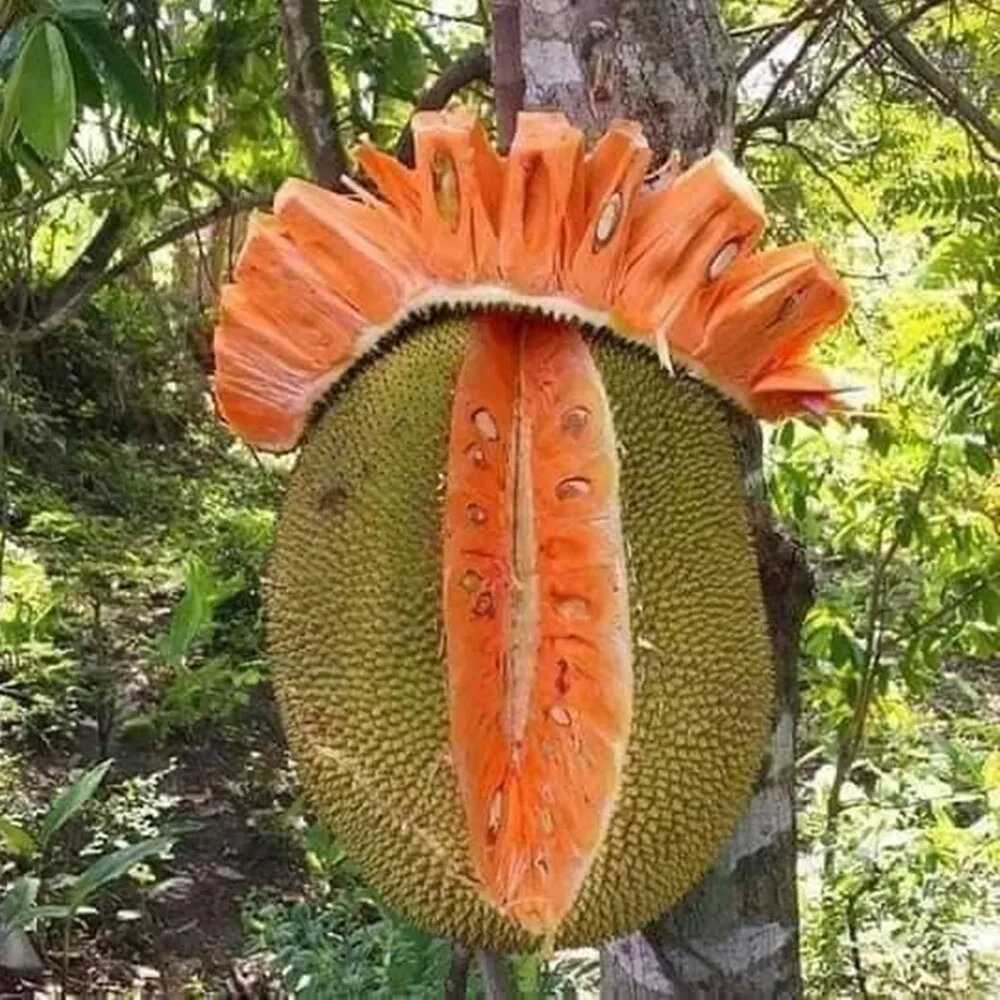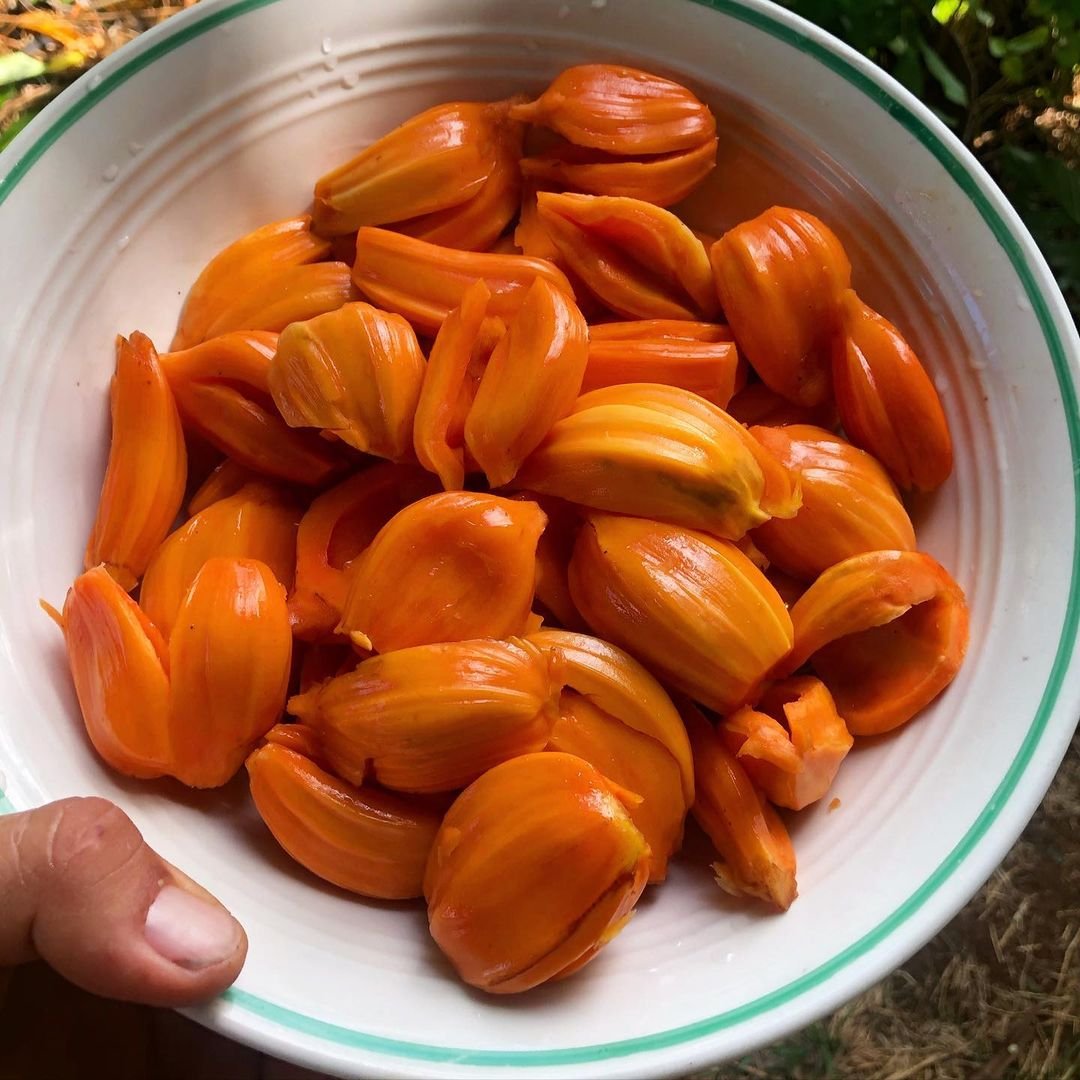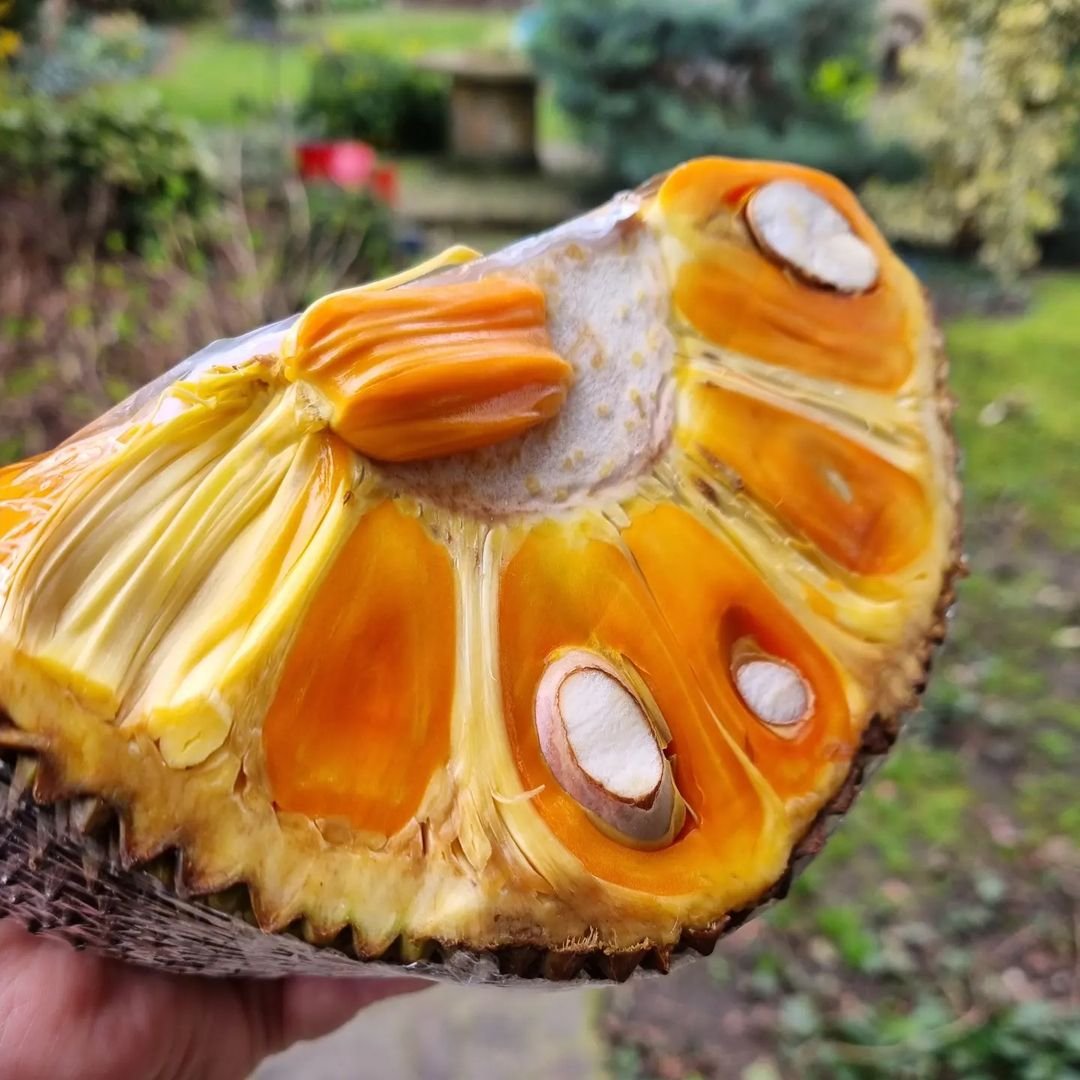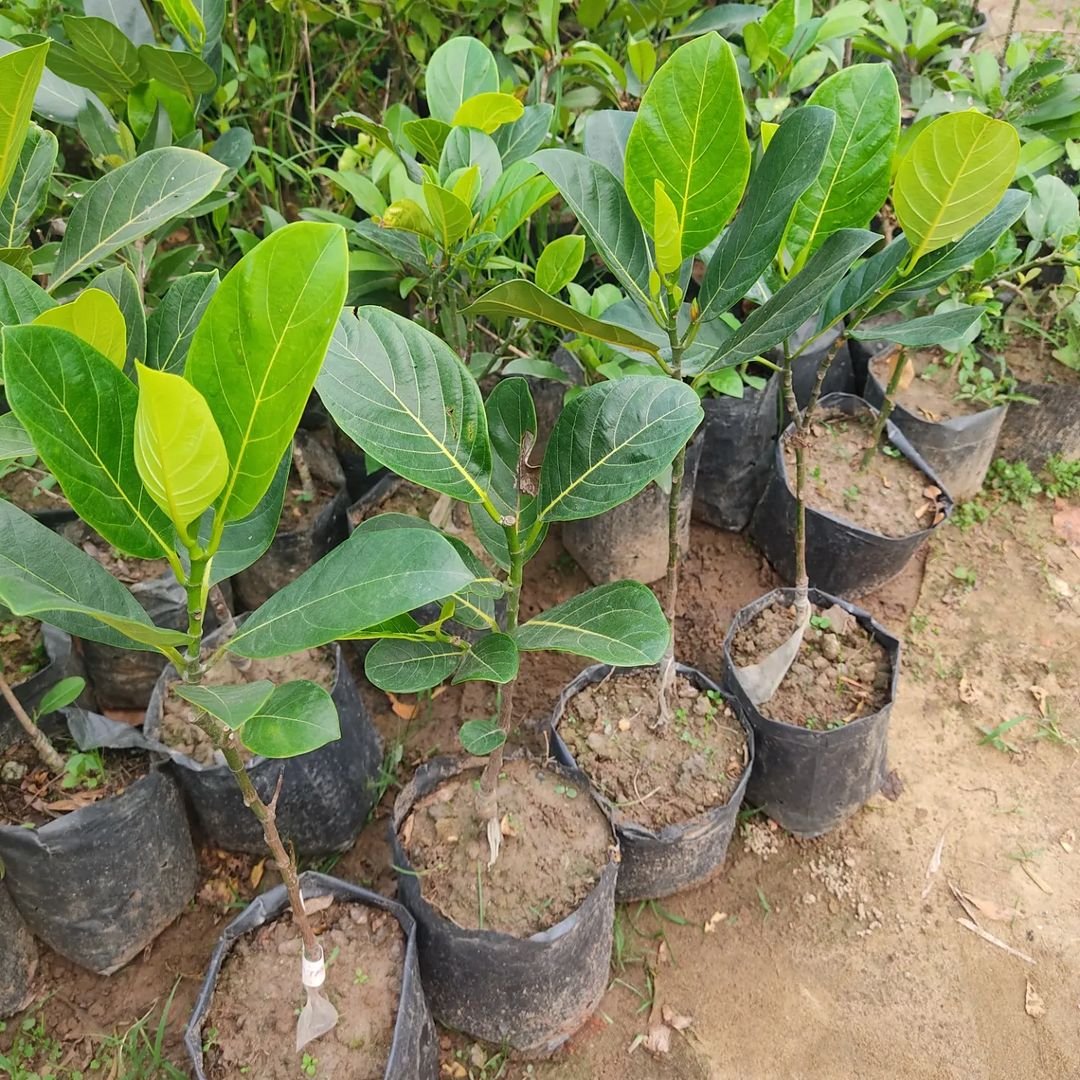Red Jackfruit is a unique tropical fruit with sweet, banana-like flavors. Learn how to grow and care for Red Jackfruit Trees, recommended varieties, and ways to use the fruits.
If you love exotic tropical fruits, you’ll definitely want to get acquainted with Red Jackfruit! This relative of the more common green jackfruit produces massive fruits with strikingly red, tomato-like arils packed inside.
While green jackfruit has more of a neutral flavor used in savory dishes, red jackfruit is prized for its sweet, banana–pineapple taste. The gorgeous ruby-red arils make for a spectacular visual impression too.
Native to the tropical rainforests of Southeast Asia, red jackfruit has been cultivated and revered for centuries. It takes some patience to grow these large trees, but their unique fruits are well worth the effort if you live in a warm, humid climate.
Here’s a concise information chart about Red Jackfruit :
| Attribute | Information |
|---|---|
| Botanical Name | Artocarpus heterophyllus |
| Plant Type | Tree |
| Zones | 10-11 |
| Exposure | Full sun |
| Bloom Time | Throughout the year |
| Height/Spread | 30-70 feet tall, 30-40 feet spread |
What is Red Jackfruit?

Red jackfruit (Artocarpus hypargyreus) is a variety of jackfruit separate from the more familiar green jackfruit (Artocarpus heterophyllus). Both are tropical evergreen trees in the fig family that can reach towering heights of 30-80 feet.
But what sets red jackfruit apart is its massive fruits that turn a brilliant crimson-red when ripe. These oval to oblong fruits can easily reach 10-25 lbs, sometimes much larger!
Inside the tough, knobby rind is a dense cluster of hundreds of fleshy arils or bulbs. As the fruit ripens, these arils shift from pale yellow to bright red, orange or pinkish hues with a soft, custard-like texture.
The aroma is often compared to fragrant pineapples with sweet, fruity notes of banana, mango and pineapple. Fans of durian may also detect hints of that unique tropical flavor too.
Ripe red jackfruit only has a brief shelf life of 2-4 days after harvesting before quickly becoming overripe. But the fruits, seeds, and even the trees themselves offer some remarkable uses.
Benefits of Red Jackfruit

Beyond being a delicious and visually stunning fruit, red jackfruit offers some excellent benefits, including:
- Packed with nutrients like vitamin C, potassium, calcium and antioxidants
- Good source of dietary fiber to promote healthy digestion
- Seeds are also edible when roasted or boiled, with a nutty almond-like flavor
- Trees can live over 100 years and produce for many decades
- Fallen leaves, twigs and fruits make excellent mulch and compost
- Wood from the trunk is water-resistant and used for furniture
- Rapid growth rate once established as a fruiting tree

Red jackfruit is cherished across Southeast Asia for both its culinary uses and cultural significance. The trees provide generous yields of 100-200 fruits annually once mature.
While the massive fruits can take some getting used to, red jackfruit delivers big tropical flavors perfect for juices, jams, ice creams and other treats. Locals even enjoy the seeds as a nut substitute.
Growing Red Jackfruit Trees
With their ultimate heights reaching 80 feet or more, red jackfruit trees require a good bit of space and sunlight in the landscape. Here are some key tips for growing them:
Climate and Location

Red jackfruit is best suited for USDA Hardiness Zones 11 and above. It cannot tolerate any freezing temperatures and needs consistently warm conditions year-round to produce fruit.
The ideal climate is hot and humid, similar to the native rainforest environments of Southeast Asia. Areas with cool winter months are simply too cold for these strictly tropical trees.
Full sun exposure is also required, with at least 6-8 hours of direct sunlight daily. Plant them in an open area free from shade or competition from other trees.
Well-drained yet moisture-retentive soil is preferred. Work plenty of compost or manure into planting holes to improve fertility and drainage.
Planting and Spacing

Plant young red jackfruit trees in early spring after danger of frost has passed. Space trees 30-50 feet apart from other plants and structures to accommodate their massive size.
When planting, dig a hole 2-3 times as wide as the root ball but no deeper. Set the root ball at the same level as the surrounding soil and backfill, firming gently.
Water thoroughly and maintain consistent soil moisture without oversaturating until the tree is well-established after 1-2 years.
Care and Maintenance

Once settled in, red jackfruit is remarkably low-maintenance, only requiring basic care:
- Deep water monthly during the dry season
- Fertilize with a balanced fertilizer formula 2-3 times per year
- Apply 4-6 inches of mulch around the base to retain moisture and suppress weeds
- Prune off any dead, rubbing or crowded interior branches annually
- Stake young trees for the first 2-3 years to develop a strong trunk
Mature trees will begin producing fruits 3-8 years after planting depending on variety. The heavy 10-20+ lb fruits often require bagging or catch frames to prevent injury from dropped fruits.
Red jackfruit is generally unbothered by pests or diseases when grown in suitable climates with good cultural practices.
Popular Red Jackfruit Varieties
There are only a handful of named cultivars available, with many local seedling types grown across Southeast Asia too. Here are some of the most flavorful red jackfruit varieties:
Seminyo or Singapore Red – Large fruits up to 25 lbs with sweet, juicy red arils
Madu or Honey Sweet – A compact tree with elongated fruits and delicious, fragrant pulp
JF Gading – Early ripening red jackfruit variety with purple highlights
Tekam/Bangkok Red – Classic red jackfruit from Thailand with delightful aroma
Siding/Malaysian Red – An heirloom variety from Malaysia noted for soft, cottony flesh
DID Pandan – This dwarf variety only reaches 12-15 feet tall when mature
No matter which specific cultivar you’re able to source, growing red jackfruit is sure to be a memorable and delicious experience! Just be prepared to share your bountiful harvests with friends and neighbors.
With some patience and the right climate, these spectacular trees will produce unique fruits like little else in the world of gardening. Red jackfruit deserves a chance in any tropical fruit orchard or backyard food forest.
Pingback: A Comprehensive Guide to Growing Red Jackfruit ...
Pingback: Grow Your Own Wisteria from Seeds: A Step-by-Step Guide -
Pingback: Gooseberry Gardening: A Complete Guide to Growth and Care
Pingback: Trees That Start with N : Choosing the Best Guide
Pingback: Growing a Fruitful Mango Tree : A Global Perspective - Gardener's School
Pingback: 15 British Garden Birds You Can Find in Your Garden - Gardener's School
Pingback: Nature’s Beauty : Trees That Start with ‘Q’
Pingback: Lychee Legends : Unveiling the Secrets of Successful Growth